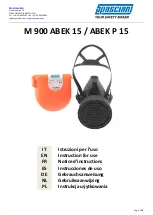
Cables
The 8-core analogue cable type SPN1/w-05 is provided for connecting the
SPN1 to a data logger and to carry power to the internal SPN1 heater.
It is 5m long with a weatherproof M12 8-pole connector at the SPN1 and
with bare wire flying leads at the logger end.
Analogue extension cables type EXT/M12-x, where x = 5, 10 or 25m are
available for extending the cable from SPN1 to logger.
The 5-core serial cable type SPN1-RS232 is provided for connecting the
SPN1 to a PC and is intended primarily for set-up and testing.
It is 1.5 m long and terminated in a 5-pole M12 connector at the SPN1 and
a DB9 connector at the PC end.
Note: The DB9 connector is not weatherproof.
Serial extension cable type SPN1-RS-10 is available in 10 m lengths to
extend the SPN1-RS232 cable. It terminates in IP-68 weatherproof M12 5-
pole male and female connectors.
For extension cabling options from the PC to a GP1 logger see the
GP1/DL6 Network Quick Start Guide
on the Delta-T Software and
Manuals CD
Power considerations
The SPN1 is a powered sensor. There are three possible sources of
power:
1. Power from the data logger. This only needs to be applied when the
logger takes a reading. The SPN1’s Total, Diffuse and Sun outputs on
the analogue output connector are valid 100ms after power is
applied, and are updated every 100ms. These analogue outputs are
only enabled when there is a voltage present on the data logger
power input.
2. Power from the 12V heater supply.
3. Power from the serial cable. The SPN1 draws power from the PC
DTR signal. Most computer serial ports will provide enough power for
the SPN1 sensor electronics (but not its heater).
If more than one of these sources is present, then power is generally
taken from the source with the highest voltage.
You can prevent power being drawn from the data logger by including a
10k resistor in the logger power cable, as long as power is available from
elsewhere, e.g. from the heater supply.
SPN1 User Manual v1.0
Introduction
z
9










































